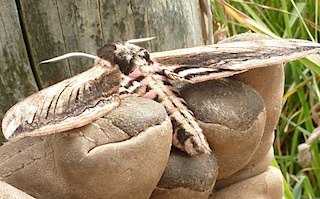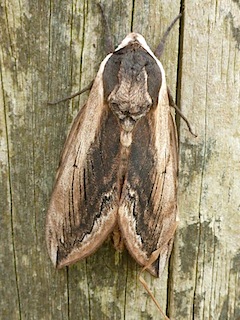 This lovely Privet Hawkmoth was spotted at Caerthillian, resting on a fence.
This lovely Privet Hawkmoth was spotted at Caerthillian, resting on a fence.
Photo: Steve Townsend
Scientific name: Sphinx ligustri
Cornish name: ‘Gouwan’ is the general word for moth
What to look for:
- Colouring: Dark-brown and buff forewing, pink and black bands on hindwing and on abdomen. The caterpillars are a lime-green, with purple and white streaks and yellow spots, and can grow to over 8 cm in length.
- Size: Wingspan, 12 cm.
- Where: Common in the south, localised distribution in the midlands, and less frequent in the north and Scotland. In Wales this species is mainly coastal.
- When: On the wing in June and July.
- Similar species: Pine Hawkmoth, Convolvulus Hawkmoth, both of which are more grey in colouring.
 The Privet Hawkmoth is an impressive-looking creature. The largest of our resident hawkmoths, this night-flyer will come to light and so is a reasonably common moth-trap find. You might also spot a freshly emerged individual – this species often rests on a vertical surface before taking flight. With its dark brown and buff forewings held close over its body, it will stay stock-still, confident in its camouflage. When it opens its wings, however, you’ll be able to spot the delightful pink and black banding of its abdomen and hindwings.
The Privet Hawkmoth is an impressive-looking creature. The largest of our resident hawkmoths, this night-flyer will come to light and so is a reasonably common moth-trap find. You might also spot a freshly emerged individual – this species often rests on a vertical surface before taking flight. With its dark brown and buff forewings held close over its body, it will stay stock-still, confident in its camouflage. When it opens its wings, however, you’ll be able to spot the delightful pink and black banding of its abdomen and hindwings.
 Its common name gives away its main larval foodplant, but the caterpillars will also eat ash and lilac bushes. As they mature they turn from lime green to a reddish-pink, and then pupate over the winter deep in the soil.
Its common name gives away its main larval foodplant, but the caterpillars will also eat ash and lilac bushes. As they mature they turn from lime green to a reddish-pink, and then pupate over the winter deep in the soil.
Did you know…?
…A male Privet Hawkmoth can make a warning hissing noise when disturbed, but it’s not using its mouth. It makes the noise by rubbing together scales and spines located at the end of its abdomen.
More information and references:
Chinery, M., 2005. Collins Complete Guide to British Insects. Collins, London.
Crafer, T., (compiler), 2005. Foodplant List for the Caterpillars of Britain’s Butterflies and Larger Moths. Atropos Publishing, Holmfirth, UK.
Waring, P., Townsend, M. and Lewington, R., 2009. Field Guide to the Moths of Great Britain and Ireland (second edition). British Wildlife Publishing, Gillingham, Dorset.
Published: July 2015
Author: Amanda Scott
Photos: Steve Townsend
